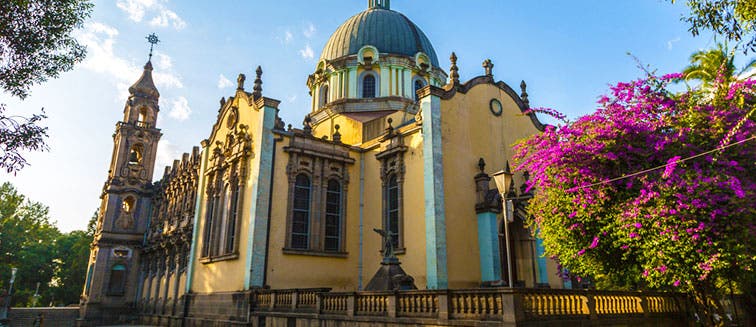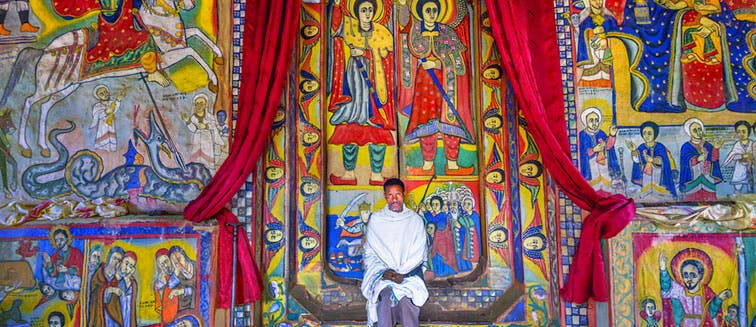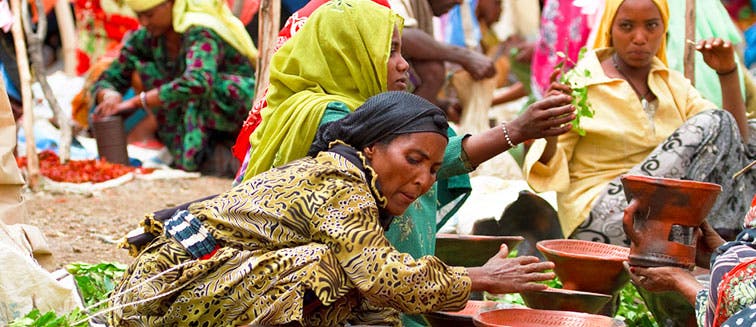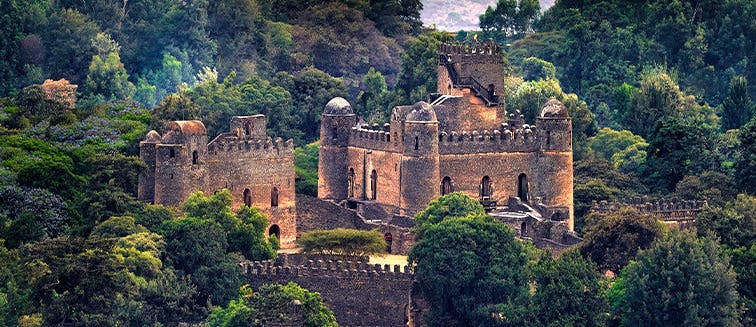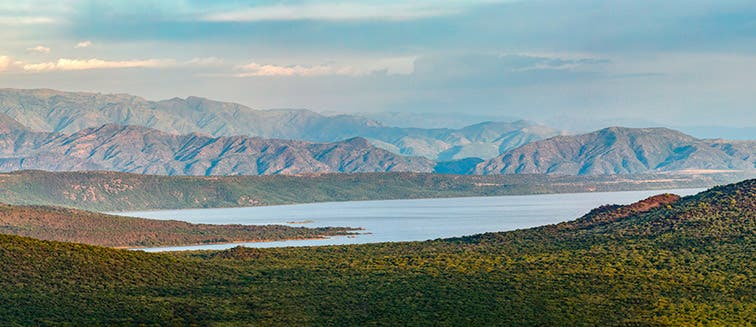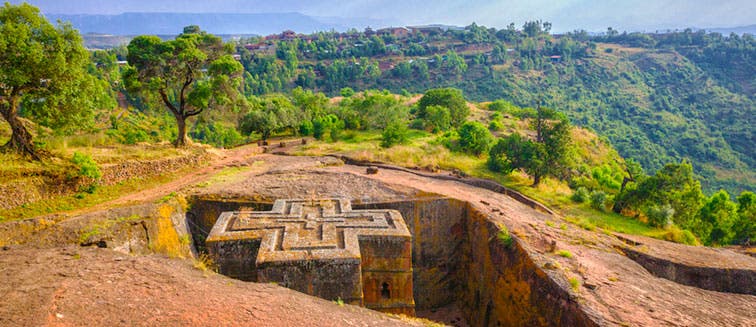Thought to be the ‘cradle of human civilisation’, Ethiopia is a landlocked nation in the Horn of Africa. Famed for its ancient dynasties, traditional tribes and historic relics of the past, such as the rock-hewn churches of Lalibela, Ethiopia holidays should be at the top of the list for all who want to uncover the origins and history of modern civilisation.
As the most populous landlocked country in the world, Ethiopia shares borders with Eritrea, Djibouti, Somalia, South Sudan, Sudan and Kenya. The vibrant capital of Addis Ababa has gained a great reputation for its trendy music and gastronomic scene, and as being the home of ‘Lucy’, the remains of the earliest human ancestor ever discovered, who now resides in the National Museum. Historic cities such as Gondor and Axum tempt travellers to step back in time through the ages, with ancient obelisks and imposing castles in a variety of architectural styles.
On the other hand, the vast Omo Valley is the cultural centre of Ethiopia, home to a number of different tribes and rural communities. A trip to Ethiopia and the Omo Valley brings you into direct contact with distinct and authentic tribes, allowing an insight into the traditions and lifestyles of the people who can trace their ancestors to these ancient lands. Untouched landscapes can be found between the vibrant cities and charming villages, whilst the imposing Simien Mountains provide a dramatic backdrop for adventures in the north of the country.
History of Ethiopia
The wonders of the past are at the heart of any trip to Ethiopia, and relics of the nations rich heritage can be found through the country. Ethiopia is considered to be the region from which modern humans originated, and the oldest humanoid ancestor, ‘Lucy’, can be found in the capital, having been discovered in 1974 near the village of Hadar. A system of governance, resembling a monarchy, was established in Ethiopia as early as the 2nd millennium BC and remained as such for most of the country’s history.
Famously, Ethiopia retained its independence throughout the centuries, and unlike many other African nations, did not succumb to European colonisation during the ‘Scamble for Africa’. Instead, Ethiopia’s history is characterised by great kingdoms and dynasties, such as the mighty Kingdom of Axum, considered, during the early centuries, to be one of the four great powers of the world!
Today, if you visit the city of Axum during a Ethiopia tour package, you can explore the reign of this great empire and see relics such as the towering Obelisk of Axum, a 24-metre obelisk, believed to have been used as a burial marker. Other ancient relics, such as the 11 rock-hewn churches of Lalibela, also remain well preserved. These iconic churches were constructed in the 11th-century by King Lalibela of the Zagwe dynasty.
The dynasty that most shaped modern-day Ethiopia was the Solomon dynasty, who ruled for over 700 years. Under this dynasty, Ethiopia made contact with European powers during the Middle Ages, and despite the help of Portuguese during the Abyssinian-Adal war, Europeans were eventually expelled from the country when the monarchy deemed they posed a threat to the stability of the Ethiopian Orthodox Church.
Visitors on a holiday to Ethiopia might remember the days of Emperor Haile Selassie, who’s reign characterised much of the 20th-century. During this tumultuous period, Italian forces invaded and occupied Ethiopia between 1936 and 1941, forcing Haile Sellasie to address the League of Nations, appealing for help to stop the invasion of his nation. British forces reacted by pushing out Italian fascists and the Anglo-Ethiopian Agreement of 1944 sealed Ethiopia’s sovereignty.
In the later 20th-century the 1974 military, Soviet-backed coup dethroned Emperor Selassie and established a one-party Soviet state. Violent political repression followed, in an era known as the ‘Red Terror’, when an estimated one-third of the population was killed. Democracy was not reinstated in Ethiopia until 1991, following the widespread and devastating famines of the 80s.
Nature in Ethiopia
With landscapes ranging from the valleys and hilltops of the Simien Mountains to the molten Danakil Depression, one of the hottest places on earth, Ethiopia has plenty of unique and endemic wildlife to satisfy safari lovers. 31 endemic species, such as the rare Ethiopian Wolf can be sighted in the country, as well as a rich range of bird species, making an Ethiopian tour a great choice for avid bird-watchers.
Even if your tour of Ethiopia is focused on the cultural sights, you’ll still be astounded by the natural beauty of the country outside of the vast urban sprawl of the capital. The Blue Nile Falls, known as the ‘great smoke’ is one of the most famous natural attractions, whose mighty 45 metre high waterfalls serve the important purpose of isolating Lake Tana from the rest of the River Nile, encouraging unique wildlife in Lake Tana itself.
This huge lake is a UNESCO Biosphere Reserve with distinct fish and bird species such as pelicans and softshell turtles. A different landscape altogether, the Bale Mountains, in the highlands of southeast Ethiopia, is home to picturesque alpine scenery and rich animal life, including the elusive Ethiopian wolf and unique plants and flora.
Culture in Ethiopia
Ethiopian culture is highly diverse and one of the major reasons for the country’s popularity as a travel destination. More than 80 different ethnic groups make up the huge population of over 100 million, who speak around 90 different languages. The most widely spoken are Oromo, Amharic and Somali. Religion has played a major role in the history of Ethiopia and is at the heart of national culture.
There are large Christian and Islamic communities, as well as many followers of traditional beliefs, making it a fascinating destination for discovering the local culture. The region, official named as the Southern Nations, Nationalities and People’s region, is home to numerous tribes and communities such as the Hamar, Mursi and Sumur people, who live very traditionally, each possessing their own distinct cultural practices that have survived the threat of modernity.
Many tours of the Omo Valley pay homage to these communities and include visits to different villages where travellers can get to know the ways of life of the numerous tribes. In the capital of Addis Ababa, where much of the population live, there is a great up-and-coming music scene, vibrant locals and plenty of trendy bars and restaurants for a slice of modern Ethiopian culture. It’s also the best place to sample the national cuisine, so a must-visit for foodies!
Visit Ethiopia to discover the land where you can trace the origins of mankind, meet distinct tribal communities and watch the sunrise over the mythical Simien Mountains. A trip to Ethiopia is sure to be an eye-opening and soul-stirring experience, no matter the path you choose.

